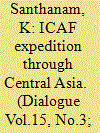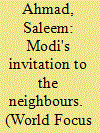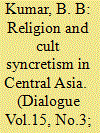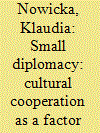|
|
|
Sort Order |
|
|
|
Items / Page
|
|
|
|
|
|
|
| Srl | Item |
| 1 |
ID:
129407


|
|
|
|
|
| Publication |
2014.
|
| Summary/Abstract |
In a global milieu where traditional interstate diplomacy is often forced to underplay critical dynamics such as the role of culture, education, entrepreneurship and tourism in bilateral ties, there is a need to establish other channels of communication and interactions between States. These are not seen as alternatives but as complementary modules for enhancing cooperation between States. The India Central Asia Foundation's (ICAF) expedition through Central Asia covering the three countries of Kazakhstan, Kyrgyz Republic and Uzbekistan qualifies as a worthy endeavour premised on this principle of Track II diplomacy. The driving expedition was organised by the ICAF during September 18 - October 05, 2013. The 16-member expedition covered 5700 km in three countries - Kazakhstan, Kyrgyz Republic and Uzbekistan in 18 days. The team brought various skills to the venture, from knowledge of the history of
the places to politics and economics. It included people who could speak the local languages. The members left New Delhi on September 18, 2013 by Air Astana and reached Astana via Almaty the same day at 21:30 hrs (Kazakhstan time). During the seven day expedition in Kazakhstan, the destinations covered were Astana, Karaganda, Balqash, Taldyqorgan, Jarkent, Khorgos (including Khorgos in Xinjiang province of China also) and Almaty. The next three days (Sept 25-27) were spent in Bishkek and Osh in the Kyrgyz Republic. We covered Andijon, Ferghana, Kokand, Tashkent, Samarkand, Bukhara, Khiva (Khwarizm) and Urgench in Uzbekistan during the next 8 days.
|
|
|
|
|
|
|
|
|
|
|
|
|
|
|
|
| 2 |
ID:
133905


|
|
|
|
|
| Publication |
2014.
|
| Summary/Abstract |
"A resurgent India must get its rightful place in the comity of nations and international institutions. The vision is to fundamentally reboot and reorient the foreign policy goals, content and process, in a manner that locates India's global strategic engagement in a new paradigm and on a wider canvass, that is not just limited to political diplomacy, but also includes our economic, scientific, cultural, political and security interests, both regional and global, on the principles of equality and mutuality, so that it leads to an economically stronger India, and its voice is heard in the international fora.
|
|
|
|
|
|
|
|
|
|
|
|
|
|
|
|
| 3 |
ID:
129408


|
|
|
|
|
| Publication |
2014.
|
| Summary/Abstract |
The famous Nicolo seal with a four-armed deity, having in his four hands a wheel, a mace, a ring like object and a globular thing, with a devotee standing by his side in respectful pose with folded hands, was
described by Cunningham in the Numismatic Chronicle as Vishnu, the deity and King Huvishka, the attending devotee. The Kushana identity of Huvishka was identified because of the affinities of headdress and garment.1 Right interpretation of the seal, however, was possible only after correct decipherment of the inscription by R. Ghirsman.2 The inscription, according to him, was in Tokharian script and in Tokharian language; it contained the names of Mihir (the Sun God), Vishnu and Shiva. But the devotee, according to him, was some unknown Hapthalite Chief, rather than the Kushana King Huvishka. Any way, irrespective of the identity of the devotee, the use of Tokharian script and language made it clear that composite cult of Shiva (Siva), Vishnu (Visnu) and Mitra was popular in Central Asia.
|
|
|
|
|
|
|
|
|
|
|
|
|
|
|
|
| 4 |
ID:
167138


|
|
|
|
|
| Summary/Abstract |
Poland and Ukraine share a long and complicated history with some really dramatic events which still overshadow relations between both nations, especially those which took place in Volhynia and other areas with a mixed Polish–Ukrainian population during 1943–1945 when soldiers of the Ukrainian Insurgent Army (UPA), the military wing of the Organisation of Ukrainian Nationalists – Bandera faction (OUN-B), planned and carried out the extermination of the Polish population. What is more, the nationalists killed several hundred Ukrainians as all manifestations of friendliness towards Poles were regarded as acts of collaboration with the enemy and a betrayal of national ideas. The main difference between the approach of Polish and Ukrainian historians is the terminology which they use to describe and evaluate those events. The endless public discussions, often accompanied by negative emotions, continues to heat up the historical debate. The Volhynia massacre, as it is often called in Poland, or the Volhynian tragedy, the term used by more moderate Ukrainian researchers, still overshadows Polish–Ukrainian relations. The echoes of this historical conflict (some historians claim that the Volhynian events were a continuation of the Polish-Ukrainian war of 1918–1919 for control over Lviv and Eastern Galicia) also exert a significant influence on the political decisions made by both countries with regard to commemoration of the victims – for indeed, they have become an element of the Polish–Ukrainian conflict of memory. During the communist period, there was no opportunity to talk openly about the history and conflict that divided the two nations. Nowadays, there are many initiatives aimed at reconstructing the past and building a new future. Many of these are inspired by culture and take advantage of its various forms. This article discusses detailed research on how city twinning and cultural cooperation can become a tool of small diplomacy. The case of Ukrainian Lviv and its six Polish partner cities has been studied.
|
|
|
|
|
|
|
|
|
|
|
|
|
|
|
|
|
|
|
|
|